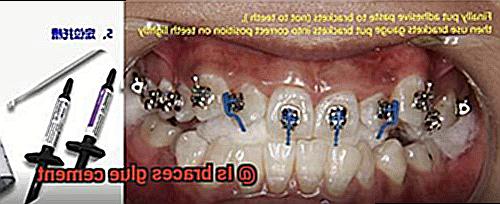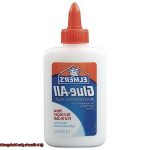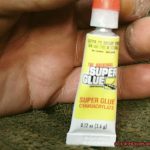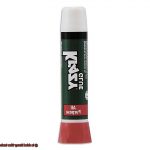Ever wondered what keeps those shiny metal brackets securely in place during your orthodontic journey? Brace yourself, because we’re about to dive into the captivating world of braces glue cement.
It may sound like something you’d stumble upon in a DIY project, but brace glue cement is actually a specialized adhesive that works its magic to keep your braces firmly affixed to your teeth. In this blog post, we’ll unravel the mysteries behind this mesmerizing dental innovation by exploring what it’s made of, how it works, and why it’s an essential component of your brace-face transformation.
So get ready to discover why braces glue cement is way more fascinating than you might think.
What is Braces Glue?
Contents
- 1 What is Braces Glue?
- 2 Components of Braces Glue
- 3 Purpose of Braces Glue
- 4 Preparing the Tooth Surface for Applying Braces Glue
- 5 Applying and Hardening the Braces Glue
- 6 Weakening of the Adhesive Over Time
- 7 Reattaching Loose or Detached Brackets
- 8 Differences between Braces Glue and Other Types of Adhesive
- 9 Conclusion
Braces glue, also known as orthodontic adhesive, is a remarkable dental cement that plays a crucial role in orthodontic treatment.
This specialized glue is the secret behind the secure attachment of braces to the teeth, allowing for gradual tooth movement and the ultimate transformation of smiles.
In this blog post, we will delve into the world of braces glue, exploring its purpose, ingredients, application process, and potential risks.
The Purpose of Braces Glue in Orthodontic Treatment:
Braces glue serves as the sturdy foundation that holds the braces firmly in place throughout the treatment duration. By ensuring a secure attachment between brackets and teeth, braces glue enables controlled tooth movement, gently guiding them into their desired position. This essential adhesive allows for gradual adjustments and aligns the teeth for a beautiful smile.
Ingredients and Composition:
At the heart of braces glue lies an adhesive resin composed of bisphenol A-glycidyl methacrylate (Bis-GMA) and urethane dimethacrylate (UDMA). These carefully selected chemicals possess excellent bonding properties, guaranteeing a reliable connection between brackets and tooth enamel.
The composition undergoes rigorous testing to ensure biocompatibility, resistance to oral bacteria, and compatibility with saliva and food. This ensures not only a strong bond but also safety and durability throughout the orthodontic journey.
Application Process:
The application process begins with meticulous tooth preparation. The orthodontist cleans and dries the tooth surface before applying a special etching gel or liquid. This preparation creates microscopic pores on the enamel, enhancing the bonding between tooth and braces glue.
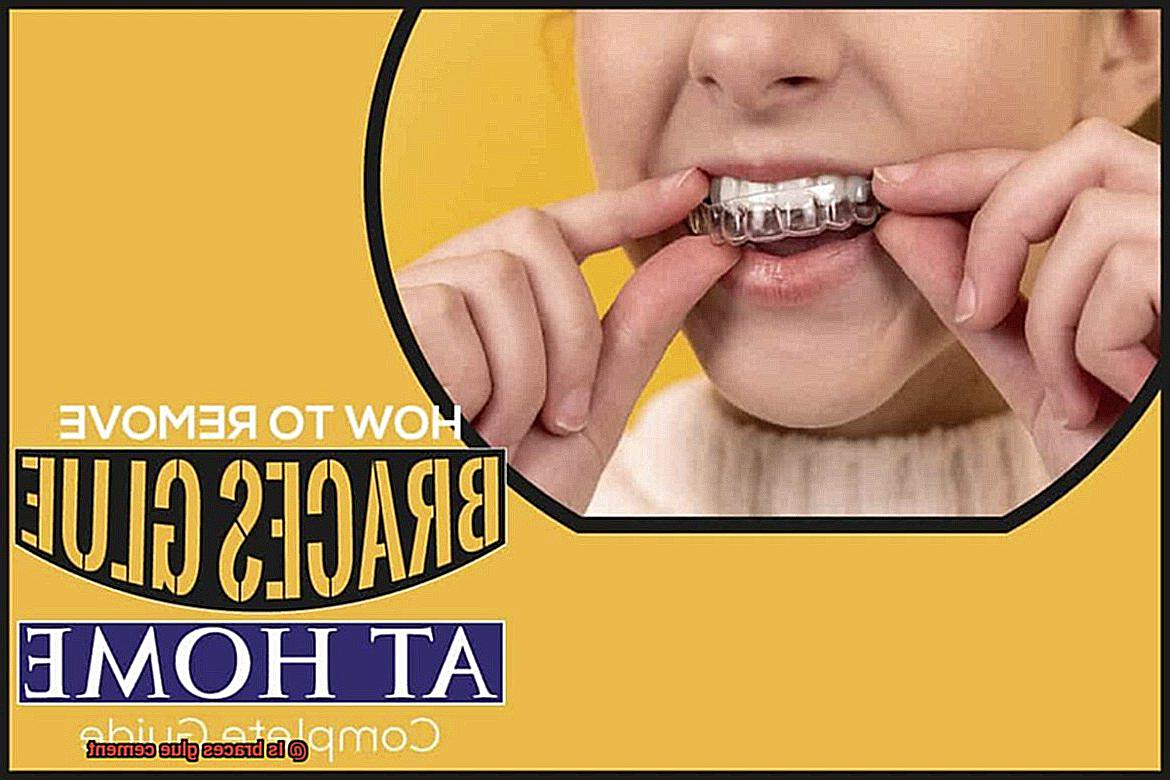
With precision and expertise, the orthodontist places a small amount of braces glue onto each bracket, securing them onto each tooth according to the treatment plan. Excess glue is removed, while any gaps between bracket and tooth are filled to prevent food particle entrapment.
The final step involves using a high-intensity light to cure or harden the braces glue, solidifying the bond in a matter of seconds.
Potential Risks:
While braces glue is designed for safety and effectiveness, it is not entirely risk-free. Factors such as wear and tear, changes in saliva composition, or poor oral hygiene can weaken the adhesive over time. Regular visits to the orthodontist are vital to monitor the condition of the braces glue and make any necessary adjustments. Promptly contacting the orthodontist if a bracket becomes loose or detached ensures timely reattachment using fresh braces glue.
Components of Braces Glue
Brace yourself for the fascinating world of braces glue. This adhesive marvel is composed of various components that work together to create a strong and reliable bond between the brackets and your teeth.
At the core of braces glue lies a special type of resin. This remarkable substance possesses a unique property: it hardens when exposed to light. The resin is carefully formulated with a mixture of monomers and polymers, ensuring optimal performance for dental use. Once the light activates the resin, it transforms into a sturdy adhesive, firmly attaching the brackets to your teeth.
But braces glue is more than just resin. It incorporates other essential ingredients to enhance its properties and guarantee effective bonding. Let’s delve into these components:
- Fillers: These additives play a vital role in strengthening the glue. They enhance its viscosity, stability, and structural support. Fillers prevent shrinkage during the curing process and provide additional reinforcement, ensuring your braces stay securely in place.
- Pigments: Brace yourself for some color. Pigments are incorporated into the adhesive to give it an eye-catching hue. Whether you prefer a clear, white, or tooth-colored adhesive, braces glue offers options to suit your style. So not only does it hold your braces together, but it also adds a touch of personal flair.
- Initiators: These chemical wizards kick-start the hardening process of the resin. When exposed to a specific wavelength of light, initiators activate and trigger polymerization. This reaction causes the adhesive to solidify rapidly, creating an unbreakable bond between your brackets and teeth.
- Stabilizers: To ensure long-lasting performance, braces glue contains stabilizers. These clever ingredients protect the adhesive from environmental factors like moisture and temperature changes. By safeguarding its integrity over time, stabilizers keep your braces securely attached throughout your orthodontic journey.
It’s important to note that different manufacturers may use slightly different formulations for braces glue. Orthodontists carefully select high-quality adhesives that meet their specific requirements for bonding strength, durability, and patient comfort.
So there you have it – the components of braces glue working in harmony to provide a strong and reliable bond. This adhesive superhero plays an indispensable role in orthodontic treatment, ensuring your braces stay put while your smile transforms. And rest assured, braces glue undergoes rigorous testing to ensure it’s safe for oral use.
Purpose of Braces Glue
Braces glue, or orthodontic adhesive, is a dental superhero specifically designed to bond those little brackets to your teeth. Its primary purpose is to create a strong and durable bond between the brackets and the enamel surface of your pearly whites. This adhesive means business.
Made of a powerful combination of resin and filler materials, braces glue has the strength and adhesive properties to withstand all the forces exerted during your orthodontic treatment without breaking a sweat. But that’s not all. It also bonds to your tooth enamel, ensuring that those brackets stay securely in place throughout your orthodontic journey. No slipping or sliding here.
And let’s not forget about oral hygiene. Braces glue is resistant to water, saliva, and other oral fluids, acting like armor for your brackets. So you can brush, floss, and rinse with confidence, knowing that your braces will stay intact.
Flexibility is another superpower of braces glue. It allows for some movement of the brackets during treatment without compromising the bond between the brackets and your teeth. So go ahead and show off those pearly whites with confidence.
When it comes to application, braces glue needs to be easy to apply and cover the bracket surface properly. It has a relatively low viscosity, allowing orthodontists enough time to position and adjust the brackets before the adhesive sets.
There are different versions of braces glue available, including light-cured and self-cured options. Light-cured adhesives need a special curing light to harden, while self-cured adhesives harden on their own. The choice depends on your specific needs and treatment plan.
Preparing the Tooth Surface for Applying Braces Glue
Before you can rock those braces like a boss, it’s important to understand the crucial steps involved in preparing the tooth surface for applying braces glue. This process ensures that your braces stay in place and do their job effectively. Let’s dive into the nitty-gritty details.
- Thorough cleaning: To start, your orthodontist or dental assistant will give your teeth a thorough cleaning using a specialized toothbrush and toothpaste. This removes any debris, plaque, or bacteria that could interfere with the bonding process. Clean teeth are happy teeth.
- Drying: Next, your teeth need to be completely dry before applying the braces glue. Any moisture can weaken the adhesive strength. To ensure dryness, an air syringe or cotton rolls are used to remove any excess moisture.
- Isolation: To keep your teeth dry and protected during the bonding process, your orthodontist will place a rubber dam or cheek retractors. This prevents saliva or other fluids from getting in the way.
- Etching: Now it’s time for the magic of etching. An etchant, usually a mild acid solution like phosphoric acid, is applied to your tooth surface. This creates micro-pores on the enamel surface, which helps the braces glue adhere better. It’s like giving your teeth a little roughing up to create a strong bond.
- Rinsing: After etching, your teeth get a good rinse with water to remove any remaining etchant. We don’t want any lingering acid on those pearly whites. Suction comes in handy here to get rid of any excess water.
- Bonding agent: Now comes the bonding agent – the secret sauce that ensures a strong bond between your tooth and the braces glue. This thin liquid is carefully applied and spread evenly over your tooth surface. Think of it as the mediator between your tooth and the braces glue, promoting adhesion.
- Drying the bonding agent: Once the bonding agent is applied, it’s time to dry it. This can be done with an air syringe or a light-curing device. The drying process sets the bonding agent and creates a sticky surface for better adhesion of the braces glue. Sticky is good in this case.
- Applying the braces glue: Finally, the moment you’ve been waiting for – applying the braces glue. Your orthodontist or dental assistant will place a small amount of glue onto each tooth where the brackets will be attached. This paste-like adhesive allows for easy manipulation and placement.
- Positioning the brackets: With the glue applied, it’s time to position the brackets onto your teeth. Your orthodontist will press them firmly to ensure proper adhesion. Any excess glue is removed, and then a special curing light is used to activate a chemical reaction in the glue, making it harden and create that unbreakable bond with the bracket and tooth surface.

Applying and Hardening the Braces Glue
Applying and hardening braces glue is a fascinating process that requires precision and careful attention to detail. Let’s dive into the world of dental cement and explore the ins and outs of this magical transformation.
Before the braces glue can work its magic, your orthodontist or dental assistant will ensure your teeth are squeaky clean. They’ll give them a thorough cleaning and drying to create a strong bond between the glue and your teeth. After all, cleanliness is the first step towards a radiant smile.
Now, brace yourself for the different forms of braces glue. It can come in paste or resin form, with varying ingredients depending on the brand or type of adhesive used. Just like a spice rack filled with unique flavors, there’s a variety of braces glue options to cater to individual needs.
The application process is where the real fun begins. Using a small brush or applicator, the braces glue is meticulously applied to the back of each bracket. Precision is key here – even distribution ensures proper bonding. The glue acts as a bridge between your teeth and brackets, creating a solid foundation for your orthodontic journey.
Once the glue is applied, it’s time to position those brackets on each tooth. Your orthodontist will carefully place them in their designated spots, ensuring they align perfectly with your dental arch. Any excess glue is removed, and any gaps or air bubbles are smoothed out for a secure fit. It’s like putting together a puzzle with ultimate precision.
Now comes the hardening part – the superhero power-up for your braces. A special light or curing device is used to activate the chemical reaction in the braces glue, causing it to harden and bond with your teeth. It’s like watching a magical transformation unfold before your eyes.
During this process, it’s important to stay still and keep your mouth open (no small feat, I know) to allow for proper bonding. The curing device emits a specific wavelength of light that acts as a catalyst, transforming the adhesive into a strong and durable bond. Think of it as a dance between science and art, creating a masterpiece in your mouth.
Once the braces glue has fully hardened, it forms a robust connection between the brackets and your teeth. This bond provides stability and support for your orthodontic treatment, ensuring that your braces stay securely in place.
Now, brace yourself for some potential discomfort or sensitivity after getting your braces glued. Don’t worry – it’s totally normal. Your mouth just needs some time to adjust to the new presence of braces. It’s like breaking in a new pair of shoes – a little uncomfortable at first, but soon you’ll be strutting with confidence.
Remember to follow your orthodontist’s instructions on oral hygiene and dietary restrictions to keep that braces glue in tip-top shape. Brushing and flossing carefully around the brackets, as well as avoiding hard, sticky, or chewy foods, will help maintain the integrity of the adhesive.
Weakening of the Adhesive Over Time
Today, we embark on a captivating exploration into the realm of braces adhesive, unraveling the mystery behind its gradual weakening over time. Brace yourselves for an enlightening journey through the forces that shape the fate of our braces.
The Constant Pressure: Bracing for Change
Braces work their magic by gently applying continuous pressure to guide teeth into proper alignment. Yet, this very force can take its toll on the adhesive holding them in place. Over time, the pressure weakens the glue, causing it to gradually break down—a subtle transformation often unnoticed by patients.
Chewing, Biting, and Brushing: A Battlefield of Wear and Tear
Consider this—every time you chew or bite down, your teeth come into contact with your braces. This perpetual movement and friction create a battleground that wears down the adhesive. And let’s not forget brushing. If you wage war on your teeth like a superhero with an aggressive toothbrush, this vigorous scrubbing can contribute to adhesive weakening.
Poor Oral Hygiene: A Recipe for Adhesive Disaster
We all know the importance of maintaining good oral hygiene, but it becomes even more crucial during orthodontic treatment. Neglecting proper care allows plaque and bacteria to accumulate around brackets and wires, creating an acidic environment that weakens the adhesive. It becomes more vulnerable to deterioration—a recipe for disaster.
But fear not. Your trusty orthodontist is here to save the day. During regular check-ups, they keep a vigilant eye on your adhesive’s condition. Should any issues arise, they work their magic to address them before they escalate into significant problems.
So fear not the weakening of braces adhesive over time. The process is gradual and often escapes our notice. Trust in your orthodontist’s expertise to ensure the effectiveness of your treatment.
Reattaching Loose or Detached Brackets
In this guide, we will explore the exciting world of reattaching loose or detached brackets. Get ready to learn some jaw-dropping tips and tricks that will keep your braces journey on track.
Step 1: Assess the Situation
Take a close look at the mischievous bracket. Is it just a bit loose or completely detached? This will help you determine the urgency of the situation. Acting quickly is crucial to avoid any delays in your treatment progress.
Step 2: Clean and Dry
Prep the area by gently cleaning around the bracket with a toothbrush and water. Ensure it’s dry as a desert before moving on to the next step.
Step 3: Temporary Fix with Orthodontic Wax
Orthodontic wax to the rescue. Roll a small piece into a ball between your fingers and place it over the loose bracket, gently pressing it against the tooth surface. This temporary fix will hold the bracket in place until you can see your orthodontist.
Step 4: Avoid Sticky Situations
While awaiting your orthodontist appointment, be mindful of your food choices. Steer clear of sticky candies and chewy treats that could cause further bracket mishaps. Stick to softer foods for now and save the crunchy snacks for later.
Step 5: Professional Reattachment
Now it’s time to put your trust in the capable hands of your orthodontist. Schedule an appointment as soon as possible to have the loose bracket reattached properly. Using dental cement or braces glue, your orthodontist will securely bond the bracket back onto your tooth surface. They may also check for any adjustments needed to keep your braces on track.
Remember, swift action and good oral hygiene are your allies in maintaining a smooth braces journey. Keep orthodontic wax handy, avoid sticky situations, and let your orthodontist work their magic. Before you know it, you’ll be flashing that perfect smile.
Differences between Braces Glue and Other Types of Adhesive
Prepare to uncover the secrets of braces glue and learn how it differs from other types of adhesive. Brace yourself for an enlightening journey through the world of dental magic.
Composition: The Perfect Blend
Braces glue is a special dental cement made from a unique combination of resin and glass ionomer. This special blend creates a strong and long-lasting bond that can withstand all the forces your teeth face daily. It’s like a superpower for your braces.
Unlike other adhesives that may take ages to set, braces glue works its magic fast. Orthodontists need it to set quickly so they can efficiently apply the brackets and adjust the wires. This not only saves time but also reduces any discomfort you may feel during the process.
Aesthetic Consideration: Invisible Magic
Nobody wants their braces to be the center of attention, right? That’s why braces glue comes in clear or tooth-colored options. This way, it blends in perfectly with the natural color of your teeth, making your braces less noticeable and magically invisible.
Strength Matters: Braces Go the Extra Mile
Regular adhesives may not have the strength needed to keep your brackets in place throughout your orthodontic journey. Braces glue is specially designed to withstand the constant pressure from orthodontic forces, ensuring your braces stay put until your treatment is complete.
Safety First: Don’t Mess with Household Adhesives.
While braces glue is safe for dental use, other types of adhesive like superglue or household adhesives are a big no-no. They’re not designed for dental purposes and can be harmful if ingested or damage your teeth and gums. Leave the dental magic to the professionals.
Conclusion
In conclusion, braces glue is indeed a type of cement.
It is a strong adhesive that orthodontists use to attach brackets to teeth during the braces installation process. This cement-like substance is specially formulated to bond securely with both the bracket and the tooth surface, ensuring that the braces stay in place throughout the treatment duration.
With its powerful grip and durability, braces glue plays a crucial role in achieving successful orthodontic outcomes.

